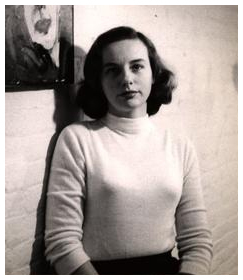Grace Hartigan (Grace Hartigan)

After studying with Muse, Grace Hartigan and her husband attempted to move to Alaska to pioneer, though they only made it to California, where Hartigan started painting. In 1945 she made the move from California to New York City, where she was a lively participant in the vibrant artistic and literary milieu of the times. Her friends included Jackson Pollock, Larry Rivers, Helen Frankenthaler, Willem and Elaine de Kooning, Frank O’Hara, Knox Martin, and many other painters, artists, poets, and writers. Hartigan gained her reputation as part of the New York School of artists and painters that emerged in New York City during the 1940s and ’50s. She was often thought of as a “second generation Abstract Expressionist”, being heavily influenced by her colleagues of the time. Though she built her early career upon more of a complete abstraction, in the early fifties Hartigan began to incorporate more recognizable motifs and characters into her paintings. In the early fifties, she actually exhibited for a time under the name George Hartigan in order to try to achieve better recognition for her work.
In the early 1950s Grace Hartigan began painting figuratively from old master paintings. Clement Greenberg, an influential art critic in New York during the mid 20th century, enthusiastically supported Hartigan’s Abstract Expressionist works, but opposed her painting figuratively. This discord resulted in her break from Greenberg. Painting from the old masters fostered Hartigan’s growth in depicting space, light, form, and structure. Some examples of these paintings are Hartigan’s River Bather s (1953), Knight, Death, and Devil (1952), and The Tribute Money (after Rubens)(1952)-working after Matisse, Durer, and Rubens, respectively. Like other pop artists ofher time, such as Andy Warhol, Hartigan painted a portrait of the iconicactress Marilyn Monroe. Her painting differs from other similar works of thattime, particularly due to her treatment. She uses bold brushwork, in addition to stippling and heavy, dark lines that give a sense of the artist in the act of painting. She worked from several photographs to create a sort of abstract painted collage whose disjointed quality was for Hartigan closer to the “real” Marilyn,than it was to the glossy facade she presented to the public that was the focus for Warhol and other Pop artists.
Grace Hartigan married Robert Jachens out of high school. They went their separate ways after Jachens came back from fighting in WWII. Harry Jackson was Grace Hartigan’s second husband. Pollock, San Miguel de Allende 1949 In 1959, Hartigan met Wilson Price, whom she soon after married. Hartigan divorced Harry Jackson so she could be with Price. Price died after a decade long mental and physical decline in 1981. Hartigan had a close friendship with Frank O’Hara. They had a falling out and did not speak for six years during the course of their friendship, but then reconnected until O’Hara’s death in 1966. Philip Guston was the artist Hartigan was closest to in the 1970s. Grace Hartigan died in November 2008.
Born
- March, 28, 1922
- USA
- Newark, New Jersey
Died
- November, 11, 2008
- USA
- Baltimore, Maryland
Other
- Cremated



